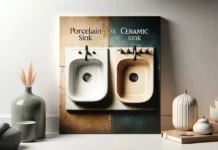When it comes to choosing the perfect tile for your home, the decision often comes down to marble versus porcelain. Both are popular choices, each with its unique advantages and aesthetic appeal. This comprehensive guide will delve into the key differences, pros, and cons of marble and porcelain tiles, helping you make an informed decision for your home renovation or decoration project.
Marble Tile
I think you will agree with us when we say that nothing man-made can ever come close to something natural. Right? The same applies to marble which is full of natural beauty and is found naturally worldwide. You might not know it, but no two pieces of marble are the same. Each piece varies when it comes to streaks and layers. We think that it is what makes marble exquisite. Its unique patterns and wide range of colors make it a sign of luxury and elegance.
Pros of Marble Tile
- Unique Beauty: Each marble tile is one-of-a-kind, featuring unique veining and natural patterns
- Adds Value: Marble floors can increase a property’s value due to their high-end appearance.
- Heat Resistance: Ideal for areas exposed to heat, as they remain cool and can withstand high temperatures.
Cons of Marble Tile
- Porosity: Marble has tiny holes in it, so it can get stained easily and needs to be sealed regularly.
- Scratch Sensitivity: It can scratch easily, demanding careful use and maintenance.
- Cost: High-quality marble is generally more expensive than porcelain.

Porcelain Tiles
The first thing that you need to know about them is that they are artificial. They are made from a specific type of clay. But that is only the tip of the iceberg. The clay alone is not enough. This is why the clay is mixed with finely ground sand and feldspar. Then the mixture is heated up at high temperatures. The result is porcelain tiles. One of the unique things about porcelain is that it can be made to look like anything, including wood or marble.
Pros of Porcelain Tile
Durability: Porcelain tiles are highly resistant to wear and tear, making them suitable for high-traffic areas.
Low Maintenance: They are less porous than marble and resist stains without requiring regular sealing.
Variety of Designs: Porcelain tiles come in a wide range of designs, including those that mimic the look of marble, wood, and other materials.
Cons of Porcelain Tile
- Hardness: While durable, their hardness makes them less comfortable underfoot and difficult to cut during installation.
- Cold Feel: They can feel cold and hard, especially in winter.
- Weight: Porcelain tiles are heavy, which can complicate the installation process.

You might like to Read: How to Make a Tile Floor Shine
Difference between Marble and Porcelain Tile
Now you know about marble tile vs porcelain tile. It is time to move towards comparison.
1. Cost
When it comes to the cost, it is challenging to make a comparison. Why? The reason is that there are too many factors that need to be considered. Usually, porcelain is cheaper than marble. However, when you incorporate the installation cost into the final figure, some porcelain tiles are expensive than some top-quality marbles. So, when it comes to porcelain vs. marble floor tile, there is no winner. The answer depends on the type and installation charges.
The typical cost for tile & installation is:
Porcelain 🡪 $8 to $15
Marble 🡪 $9 to $24
Rates may vary further depending on where you live and other factors.
2. Durability
Marble is one of the hardest materials that you can find on Earth. You can install it anywhere for any type of foot traffic without it cracking. The same does not apply to porcelain tiles. If you plan to install it in a busy commercial setting, you need one with at least 4-5 PEI (Porcelain Enamel Institute) hardness ratings. Otherwise, the tiles will begin to crack. Hence, marble is the outright winner in the durability debate in marble tile vs. porcelain tile. As technology keeps improving, we might see porcelain tiles with the same durability as marble. However, until that day comes, you need to opt for marble if you expect considerable foot traffic in your home or building.
3. Maintenance
One would think that as marble is durable, it requires little maintenance than porcelain. Unfortunately, that is not the case. Marble requires much care as it can develop stains. It can even become etched, which completely ruins its beauty. You will need a team of servants to maintain the marble. If not, it will lose its beauty a lot sooner. In comparison, porcelain offers high protection against scratches, fading, and stains. There is no need to mention the winner here as it is obvious. If you can afford to take care of the marble, we recommend it over porcelain tiles.
4. Installation
Both are equally challenging to install. We recommend that you hire the best tile installation company in your area. Otherwise, you risk damaging your tiles. We recommend researching the companies and going through their reviews before finalizing one. Ensure that you make them sign a contract that offers protection against tile damage. If you opt for marble, make sure that the delivery company takes the utmost care when loading and unloading it. The last thing that you would want is someone dropping it and shattering it to pieces.
5. Visual Appeal
We will be honest. There is a reason that marble has been the preferred choice throughout history. It is outright magnificent! Most historical buildings and sculptures are made of marble. Even though porcelain tiles can look like marble, they are no way near the original thing. Marble even increases your home’s resale value, unlike porcelain tiles. The reason is that people consider marble as classy and expensive, driving the home’s value up.
Wrap Up
Your choice between marble and porcelain tiles will depend on your budget, the intended use, and your aesthetic preferences. Marble offers unparalleled natural beauty and luxury, while porcelain provides durability, versatility, and ease of maintenance. Both have their place in the world of interior design, and the right choice varies depending on individual needs and circumstances.














